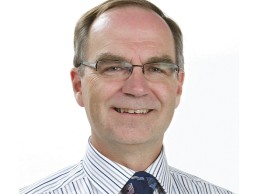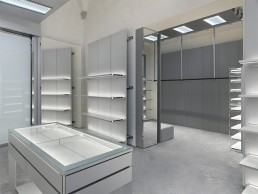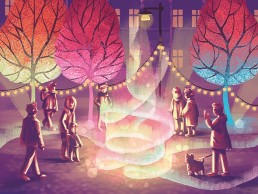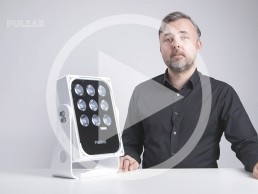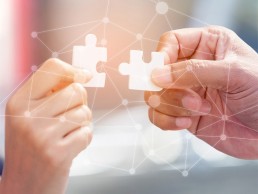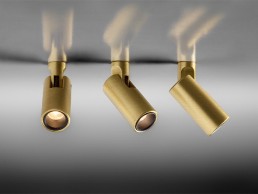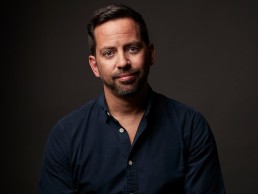LIA President’s Award winner revealed
(UK) – On 30 July, the Lighting Industry Association (LIA) held its Annual General Meeting, which concluded with the presentation of the LIA President’s Award. This year’s recipient is David Wright, Managing Director of Emergency Lighting Products and Jordan Reflectors.
The LIA President’s Award recognises exceptional service to the lighting industry, and LIA President Terry Dean bestowed the award on Wright, not just for his distinguished career in lighting, but also to acknowledge the support and guidance that he has given to the LIA and Lumicom over the years.
Wright began his career in Research and Development with Thorn Lighting followed by eight years managing the lighting laboratories at BSI (British Standards Institution). He later joined Existalite / Thomas & Betts as Technical Director, and was promoted to Managing Director while also handling the Group roles of European Product Manager and World Standards Manager. Wright joined the Jordan Group in 2003, initially as Managing Director of Emergency Lighting Products, but took control of both Jordan UK companies in 2009.
An active member of the LIA, Wright is also Chairman of the Industry Committee for Emergency Lighting (ICEL). Its mission is to strengthen the industry and promote the benefits of good quality emergency lighting. He also sits on the LIA Council of Management and is a Director of Lumicom – the UK’s leading independent, not-for-profit WEEE Compliance Scheme, which is a part of the LIA.
On receiving the award, he said: “It was an unexpected honour to receive this year’s President’s award. I am particularly delighted to have been recognised at a time when our industry has been enduring obvious difficulties and by a President that, with the Board and Council, has been so instrumental in bringing positive change to the LIA.”
LIA President, Terry Dean, added: “When it came to thinking about this year’s President’s Award, David was a quick and obvious choice. Having known David for more than 25 years, he has always struck me as someone who cares about our industry and has made a significant contribution to the LIA Council and ICEL. I’m sure you all agree he is a very worthy recipient.”
L4H Online Course is Officially Launched
(Online) - On 20th of August 2021 the online course L4H Course of Health Research for Lighting Design was officially launched. It was developed by a consortium of six partner-universities from around the world as a part of the Erasmus + Strategic Partnership grant programme. This includes Thomas Jefferson University (USA), University of Wolverhampton (UK), Aalborg University (Denmark), Hochschule Wismar (Germany), KTH Royal Institute of Technology (Sweden) and ITMO University (Russia).
The course consists of five educational modules. It contains multiple concepts, tools, and results of health-related research to inform lighting design. Students are exposed to knowledge and research related to lighting and health in different fields of physiology and psychology. They are also guided to learn how to conduct their own evaluation and data collection to enable lighting designs that support health and wellbeing. Students will also learn how to interpret the necessary measurements.
Module One introduces the topic and addresses the question of why health should be considered as a factor in lighting. Students will investigate aspects such as the physics of light and the physiology of vision, and the impact of light on the human body. The module also includes a short history of light and health.
Module Two reviews the basics of lighting and aspects of health related to lighting. This involves the role of daylight in architecture, daylight’s impact on health, and, in general, the neuroendocrine, neurobehavioral, and circadian effects of light on the human body. Students will also explore the psychology of light and additional topics such as glare and flicker are covered.
Module Three is dedicated to software, measuring devices, and evaluation tools. Metrics are provided that can be used to evaluate the physiological impact of lighting. The module also covers different software and measurement tools. Some assessment techniques for subjective impressions of a space are presented. At the end of the module there is a virtual tour of the Jefferson Research Lab.
Module Four provides an overview of standards and good practices. Metrics for daylight evaluations are presented, and students will be introduced to “Manchester Recommendations” for healthy daytime, evening, and nighttime indoor light exposure. Moreover, design integrations are discussed that employ measurements and design criteria for physiological impact and visual perception.
In Module Five, there are examples of applications and case studies from research and practice. Students will be provided with project examples from workspaces, educational, and healthcare environments, and they will be shown specialty applications (e.g., space travel, users with autism). Concepts of spectral modelling for light and health considerations, double dynamic lighting, biophilia, and information on therapeutic lighting applications will also be supplied.
Prior to the course launch, there was a conference organised by the consortium members. Those who joined the conference were lecturers, students, and professional designers. All experts agreed that the course was the result of a successful collaboration of representatives from different disciplines and different backgrounds.
Asst. Prof. Dr. Karolina Zielinska-Dabkowska from the Hochschule Wismar (Germany): “The topic of light and health is a very complex one, especially with recent medical and biological discoveries. Therefore, it’s essential that different groups collaborate in order to overcome the difficulty of putting research into practice. This collaboration requires the involvement of scientists, academics, lighting professionals, and representatives of the lighting industry. The proposed approach can help identify the gaps and then be used to find solutions to resolve those gaps.”
With lighting design as a profession developing very fast as new approaches and technology are applied, this course makes a contribution to this evolving field. Assoc. Prof. Lyn Godley, from the Thomas Jefferson University (USA) explained: “The field of lighting design has changed dramatically over the last 10 years, and it has become much more diverse in terms of what it entails regarding science, and visual and non-visual effects. For all of us working within the consortium, it’s been remarkable to team with the researchers, so that we have a dialogue together rather than separately”.
When exploring the topic of light and health it is important to understand that the numerous discussed issues extend beyond design and architecture. Asst. Prof. Dr. Georgios Triantafyllidis from the Aalborg University (Denmark) said: “10 years ago, everything was much simpler because it was only about daylight or engineering for artificial lighting, but now everything has been mixed with biology, architecture, engineering, and technology. The students are asked to understand everything, which is very difficult. That’s why I think this project, and this online course can contribute to organising and providing easy-to-understand knowledge to everybody: students, practitioners, and anyone who is a light enthusiast. Thus, we can all better understand how light works in regard to health”.
Prof. Michael F. Rohde from the Hochschule Wismar (Germany) emphasized: “I think this Erasmus + project from the EU is pointing in the right direction, and distributing this information through the website is a really good idea. It is important that we share this knowledge with all those who are interested on an international level. I think in the future, with the help of this course, students, clients, light designers, and manufacturers will comprehend how a modern, intelligent lighting concept should be developed in healthcare units or hospitals”.
The project has been extremely productive, however the field of light and health is very broad so the topic needs to be explored even further. Assoc. Prof. Dr. Ute Besenecker from the Royal Institute of Technology (KTH), (Sweden) explained: “I do think that this project provides a great starting point to bridge knowledge from research and design applications, yet it still needs to be developed to more fully integrate it.”
Head of the international Master’s program “Lighting design” from the ITMO University, Natalya Bystryantseva observed: “The L4H project appeared as a response to a global demand of the lighting industry in the development of knowledge, skills and competence for young specialists. This demonstrates that the profession of lighting designer is becoming more significant and demanding regarding the quality of lighting. Scientific and practical experience of the partners, and work with different types of spaces, have helped to specify the most relevant questions that researchers have nowadays. In the future, this course will also help enhance and systemise the knowledge of young students and graduates when they write their master’s and postgraduate theses”.
The L4H project has highlighted the importance of light and health not only for scientists and practitioners, but also for those who use lighting in their homes, working environments, and in hospitals and healthcare facilities etc. Prof. Paul Hampton from the University of Wolverhampton (UK) added: “I would also suggest that a lot of the work and intelligence we have gathered here should be shared with clients, so that clients can better understand the impacts lighting can have. This might influence them to have lighting designers involved earlier in the design stage. I think we have to move away from the attitude that lighting is something to consider later, only if there’s a little money left, whereas, it needs to be at the forefront of the design”.
The online course is available on the official site of the project (https://www.light4health.net/) under the “L4H Online Course'' tab. All course content is available for open-access use either in part or in its entirety, and free for everybody interested in the field, with proper crediting: Copyright © Light4Health 2021. For educational use only. Not for Commercial Use. Available to third parties under Creative Commons (Attribution, Non-Commercial, No Derivatives) 4.0 Public License.
For first time login, a user account needs to be created at: https://course.light4health.net. This is the same process for all users of the platform (e.g. students, teachers, professionals).
Nichia H6 LED Series
Nichia will be exhibiting at the first in-person lighting exhibition of the year at [d]arc room pop-up @ Design London on 22-25 September. [d]arc room pop-up is a dedicated lighting area within Design London, featuring a highly curated selection of brands. The exclusive event brings lighting designers, architects, interior designers, developers and retailers together under one roof.
At [d]arc room pop-up, Nichia will present its award-winning H6 LED series. This new family of LEDs delivers the highest multi-level boost in colour rendition and efficacy, while maintaining the outstanding lifetime expected from Nichia. The H6 series delivers a CRI of 90, while maintaining a level of efficacy seen in standard CRI 80 LEDs, meaning that lighting professionals no longer have to choose between high colour rendering and high efficacy.
Nichia’s H6 LED series provides better all-round performance for those luminaires targeting demanding environments, especially in shops, restaurants, hotels and galleries where colour rendering and energy savings are imperative design considerations. The solutions are particularly useful for general illumination fixtures – such as troffers, tracks, downlights and spotlights, among others – to boost the vividness of rich coloured objects as well as to set mood and add accents in retail and hospitality venues.
Nichia’s H6 series takes advantage of a unique red narrow band phosphor technology, among other semiconductor processes and packaging techniques, to develop LEDs that achieve a colour quality better than traditional CRI 90 LEDs with R9 content greater than 50 while maintaining an efficacy better than many CRI 80 LEDs. The 0.2W H6 series delivers a typical luminous efficacy of 200lm/W, a 20% increase in efficacy compared to many CRI 90 LEDs available in the market.
Nichia will be joined by Formula Luci Italia, a luminaire manufacturer specialising in luxury store lighting. Together at stand DR12, they will showcase H6 as an unrivalled lighting solution in luxury retail.
Glamox acquires Wasco
(Germany) – Glamox has acquired 100% of the shares in German lighting company Wasco. Located in Lower Saxony, Germany, Wasco specialises in continuous line luminaires.
“The acquisition of Wasco will strengthen our lighting solutions offering for logistics buildings and warehouses,” said Rune Marthinussen, CEO of Glamox. “Glamox will support Wasco’s product development strategy and we look forward to offer these innovative products to all our customers globally. Wasco will remain an independent, wholly owned subsidiary within the Glamox Group, welcoming customers both inside and outside the Glamox Group.”
The growth in eCommerce has led to an increased demand for warehouses; Wasco has proven lighting solutions that are in particular suitable for such warehouses, and highly valued by its customers. Its solutions significantly reduce product cost and installation cost compared to conventional continuous lighting systems.
Wasco founder Friedrich Habben is enthusiastic about the new opportunity: “Glamox is a very solid international lighting company with a focus on engineering and quality. Together we allow customers worldwide to discover our Wasco products and strengthen our ability to develop new lighting solutions for the future.”
Lights in Alingsås reveals theme for 2021 event
(Sweden) – Returning for its 22nd edition, the Lights in Alingsås organisers have revealed that the theme for this year’s event will be ‘Together’.
In a statement, the organisers said: “The world has changed quite a bit since the last ‘normal’ edition of Lights in Alingsås was held in 2019. The pandemic may not be over yet, but the time has come to slowly start reconvening, albeit at a safe distance.
“Autumn is around the corner, yet even as the days are getting shorter, brighter times await. Lights in Alingsås wants to kindle that sparkle of hope by turning on its lights and creating opportunities for visitors to gather once again.”
For the 2021 event, the same seven lighting designers who were scheduled to participate in last year’s workshop now get the chance to create this year’s installations. They will be joined by roughly 50 lighting design students from KTH Royal Institute of Technology and the Jönköping University. Partnerships with international schools will remain on hold until the global situation stabilises. New routines have also been established ahead of this year’s workshop to ensure all participants’ safety and to comply with current Covid-19 guidelines.
The trail for this year’s event will be around three kilometres long and will feature six installations spread out through the heart of the Swedish town of Alingsås. Both the trail and guided tours will start in Åmanska Parken. Visitors are also able to explore the installations independently via a digital guided tour in the Lights in Alingsås app. There are several additional installations and surprises for visitors to discover along the way.
Child-friendly installation Barnens Lights, which is sponsored by Sparbanken Alingsås, will be held in Museiparken. Designer and drama teacher Malin Wallin will create this installation.
The event will take place from 1 October to 7 November. Tickets for the guided tours have to be booked in advance and will be available later in September.
Pulsar: LuxEOS
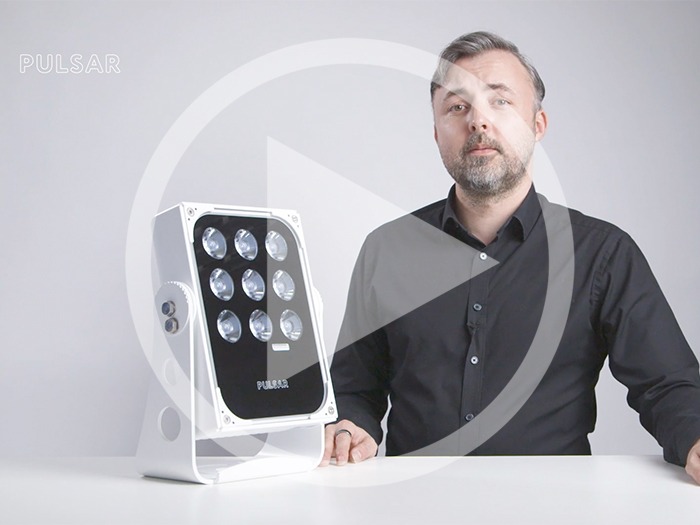
Combining advanced multi-channel LED technology and precision optics, the LuxEOS range from Pulsar has been designed to deliver exceptional quality of light and performance.
Perfectly suited to a wide range of exterior applications - from floodlighting to distance projection - LuxEOS has been engineered to Pulsar's exacting standards and constructed to withstand the toughest environments.
Available in multiple sizes and with a choice of colour-changing LED sources, including RGBW, RGBA and Tunable White, LuxEOS offers a flexible architectural lighting solution like no other.
Nichia and Zumtobel announce collaboration
(Japan) – Nichia has announced a joint-product development collaboration with Zumtobel to provide LED lighting with advanced human-centric lighting benefits.
The partnership has become a key factor for Zumtobel to develop a new offer to its customers; the recently launched Zumtobel Spectrum is a lighting solution developed for its luminaires that harness proprietary technologies developed by Nichia – especially those designed within Optisolis and Vitasolis – to produce a colour spectrum that has daylight properties as reflected by nature, instead of mimicking the conventional sky daylight spectra like other high CRI LED solutions available on the market.
“The demand for high quality, human-centric LED lighting continues to grow,” explained Satoshi Okada, General Lighting Business Planning Manager of Nichia Japan. “Nichia has been a pioneer in LED development for human-centric lighting, having already introduced our Vitasolis technology platform in 2019. With more than 65 years of research into the production and application of phosphor and LED development, Nichia is actively engaged in making scientific breakthroughs in lighting, improving its quality and our relationship with it.”
Zumtobel is also utilising Nichia’s Optisolis technology, which provides a natural light source with a spectrum that achieves the industry’s closest match to that of the standard illuminant, including both the sun and incandescent.
GreenLight Alliance: An Architectural Perspective
Perkins + Will Sustainability Director Dr. Asif Din, alongside Associate Erik Svensson, offer an outsider’s view on how the circular economy fits within the wider design approach.
At Perkins&Will, we have always been looking at the environmental impact of our projects. We are an architectural practice based in London, part of a larger worldwide company, working at a range of differing scales from masterplanning to corporate interiors. The more we quantified the impact of corporate fit outs, we found the impact was larger than first thought. This is due to the fit out of buildings being a continuous cycle of environmental impact, which eclipses the building envelope over its lifespan. We looked closely at a designer’s input and the influence we have in terms of design and specification of our projects.
Our design responsibilities are extending beyond sustainability to a circular economy mechanism to meet 2050 carbon targets. We cannot delay in providing a methodology on how this would be achieved and act immediately.
The impetus is not solely from a designers’ standpoint; there are a range of client requirements that are emerging. The concept of corporate extended responsibility requires all corporations to conduct themselves correctly, looking at their whole supply chain. Much of the funding they receive is increasingly tied to environmental indicators. Corporations are also increasingly declaring their carbon emissions with commitments to use completely renewable energy, roadmaps to zero carbon and the payments of offsets through verified methodologies such as science-based targets.
We believe that offsets should be used as a last resort to meeting carbon commitments and designers have the remit to minimise carbon within the real estate sector. There is a limited resource of offsetting that corporations can access. To reduce carbon at the earliest stage of the design that has the potential for the largest reduction of carbon.
To achieve this vision, we had to set our own roadmap. This included a commitment on transparency and reporting stages to the industry to communicate the successes but also where the gaps and failings are to achieve our milestones. A net zero carbon interior is not possible now and will require effort from the whole supply chain to achieve our 2030 target date to systemically change the way we deliver interior projects.
Our roadmap outlines a series of focus areas. While we cannot currently design a fully circular project, we can make at least one or a few areas on each project circular. The knowledge gained from each project will move us towards designing complete circular projects. This would be achieved through:
1. Sourcing materials with Environmental Product Declarations (EPDs) and/or Health Product Declarations (HPDs) supporting transparency and engaging with smaller manufacturers developing new sustainable materials.
2. Design for disassembly: consider how each component is put together and how it can be taken apart to be reused in the future.
3. Undertake a Life Cycle Analysis during the earlier stages of the design process to evaluate and highlight opportunities to reduce the project impact. This should be considered an iterative process that continues on site in collaboration with the contractor.
The incremental targets set along the timeline include processes, training, and specification changes to achieve goals. This not only effects how we design but what we design as the aesthetics move towards concepts that favour honesty of materials and how things are fitted together.
Using a Life Cycle Analysis (LCA) is the most transparent methodology to quantify where we are in the journey to achieving a net zero carbon interior. This, like any other construction project, is large in its initial amount and then decreases over the lifespan of the project. However, as the cycles are short with interiors projects, this spike occurs at a more frequent basis. Using Greenhouse Gas Emission impacts (GHG) allows us to show the impact of a range of chemicals and potentially allows the comparison of projects to take place in the future.
However, the scope of GHG quantification is limited to the closed system boundary of the site and its materials. To reduce impacts on a larger systemic level the principles of the Circular Economy (CE) are used. There are no established metrics for circularity, but a LCA impact assessment is a good fit. During the lifetime of a product, GHG reduction can be demonstrated through reuse, manufacturing of goods using different and less raw material, eliminating waste and the need to recycle at the end of the product’s life, and to increase longevity, creating a secondary market for the product.
The reality is that it is often easier and more cost effective to dispose of existing materials on project site and source all new. This is one of the many barriers our industry needs to overcome.
If the long-term goal is fully circular, there must be an invested interest from the manufacturers to receive their products back. In current design process the industry is ill prepared for circularity as purchasing reconditioned materials raises concerns, particularly around warranties. There is also often a perception of the concepts of second hand, reused or reconditioned items that must be overcome.
There are products already in the market that are moving towards a circular ethos. A good example is that of a European carpet manufacturer who offer full transparency on the list of all the ingredients that they use. They have operated a takeback service aligning with extended manufacturer responsibilities for several years but in addition have a Materials as a Service offering where the flooring is leased.
Within their manufacturing their product is fully recyclable, and they are increasing their recycled content as the feedstock from old product allows. They are only able to control this process through the ownership of their own recycling facility disassembling product to provide feedstock to mills to be made into new yarn.
We are currently working on a project in London; with the full project teams’ goals on sustainability aligning, the project is an opportunity to explore and continuously find opportunities to drive change in the industry. The project focused on circularity and going beyond sustainability accreditations from the start, creating a strong framework for the client and project team to work towards.
The project is in a previously occupied building, giving the project team a set of materials and components already installed. Repurposing elements from the previous fit out offers potential cost saving and innovative opportunities. Some are less glamorous, such as reconfiguring existing WCs rather than demolishing and installing new, whilst others can be part of a project storytelling, such as repurposing the timber from existing door frames to create handrails for new staircases.
Sourcing furniture in a more circular way, by focusing on remanufactured and reused furniture, aims to drive a much-needed shift in the furniture industry away from a linear model. According to Eramus+ (2017) approximately 80-90% of discarded furniture goes to landfill, many designed to last far longer than a typical office lease period.
Considering each material that goes into the new project can make a significant impact. For example, reducing the amount of metal used in the project by installing a glulam staircase. Each component change may not be significant in impact, but in combination creates a large difference. When we do the final LCA at the end of the project we will evaluate what we have achieved and take these learnings to the next project.
This is a journey in which we are now gaining the knowledge and clear direction to achieving a net zero carbon interior in the future. From this process we have learnt that we can only assess progress if there is a defined methodology involved. Although an LCA does not fully include CE, it does provide a good fit to the main aims of carbon reduction in interiors projects. We have discovered splitting of technical and biological components as much as possible allows better quantification and end of life processes to be made. This will require a designer mindset shift to viewing the building as a temporary material store rather than the end of the material journey occurring at hand over.
This cannot be achieved by us alone and requires the whole industry to similarly examine and deliver products in a similar light. We need transparency of material ingredients as it is the feedstock of the future building components. We need to eliminate waste through all stages of production and allow dismantling of components to be reused. This will require manufacturers to no longer view new product as a primary source of income but the responsibility of maintenance and repair to elongate life, making refurbished components the equivalent of new. This can only occur if this process is less arduous than the current practice of placing all components into a mixed recycling skip at the end of a lease period in an office fit out.
The most efficient way of reducing embodied carbon is to not install the component to start with. As designers we need to ask ourselves what the purpose of each component is, and if it really needs to be there. Whilst currently this puts restraints on the design, the industry is and will keep changing.
David Morgan Review: DGA Nano Tini
DGA’s Nano Tini was the latest miniature spotlight to take home a [d]arc award earlier this year. Here, David Morgan puts the miniscule spotlight under the microscope.
If this product review reflected the size of the luminaire under discussion it would already be well on the way to reaching its conclusion. The DGA Nano Tini spotlight is a very small luminaire indeed.
DGA was founded by Antonio Di Gangi in Florence in 1989 and the first lighting products produced by the company were based on fibre optics for use in museum and architectural projects. These early ranges included downlights, projectors, and linear systems for interior and exterior applications.
The company introduced its first LED lighting systems in 2000 and has invested heavily to create a full range of interior, exterior and underwater LED luminaires. DGA has always aimed to reduce the size of luminaires to the minimum during the design and manufacturing process.
The company undertakes the full luminaire design and development process in-house, including mechanical, thermal, and optical design, as well as photometric testing. The primary in-house production process used by DGA to produce its range of luminaires is NC machining of brass, aluminium, stainless steel, and magnesium materials. The waste material produced by the NC machining process is carefully collected for recycling to ensure minimum waste within a circular economy model. DGA aims to keep as many production processes in-house as possible and undertakes its own LED light engine assembly and powder coating of metal components.
The company currently employs 60 people in Florence and has a sales network covering all major specification markets. Focusing on the specification sector, DGA works closely both with Italian and international lighting designers.
The latest product introduced by DGA is the Nano Tini miniature spotlight, which recently won the [d]arc award for the best interior product.
The Nano Tini lives up to its name and is a very small luminaire – only 9mm in diameter and 20mm long. The miniaturisation in size is made possible by the 5mm diameter lenses used in the range. The design of this range of lenses was undertaken by the DGA design team using one of the standard optical design software systems.
Most of the small spotlights I have reviewed for arc magazine in recent years were based on a 10mm lens, such as the LEDiL Lisa range, and I was interested to compare the performance of the DGA Nano spotlight with these other products.
The sample I was given to test by DGA was fitted with a 30° medium beam lens; it performed well, producing a pleasant, soft edge spot. There were some visible striations in the output when the luminaire was placed close to the lit surface but in normal use in jewellery cases this should not cause any major problems.
The Nano Tini range includes three beam angles ranging from a 20° spot, 30° medium beam and a wide 50°. The light engine incorporates a chip scale LED mounted onto a tiny aluminium PCB. The moulded nano lens incorporates two legs that push into holes in the LED PCB, so the relationship between the lens and the LED could be somewhat variable and that might lead to changes in the beam quality or shape. The medium beam lens in this sample incorporated a series of simple domed micro lens details on the top surface, which are used to control the distribution.
The Nano Tini has a simple but effective construction. The machined brass body/heat sink hinges on the joint with a spit pin to provide friction. The LED board appears to be bonded to the machined body as there is no space for screw fixing, which might cause a few issues with recycling at the end of life. A satin black threaded snoot ring screws into the body to keep the lens in place and provides some glare control. The rest of the metal work is available in five finishes including gold, brass, polished chrome, grey and satin black powder coat.
The spotlight is mounted via an M4 threaded extension to the joint, which gives the smallest possible fixing to the mounting surface within a display case. There are currently three options for fixing the spotlight: a moulded plastic nut can be used to hold the spotlight to a mounting plate; a magnetic base is offered for use with steel panels; and a 19mm diameter surface mount base is available.
The LED light engine is available in five colour temperatures ranging from 2200K up to 4000K, all with CRI over 90. The lumen output with 350mA drive current is 50lm, which rises to 80lm with a drive current of 500mA.
The machined brass body gets quite warm after a few hours of use when run at 350mA. When run at 500mA, it is understood that the spotlight needs to be mounted onto a metal plate of undefined dimension to help dissipate the heat and keep the LED operating at a safe temperature.
The DGA Nano Tini spotlight is the smallest spotlight I have reviewed so far but it produces a useful light output that will be beneficial for the target applications of museum and jewellery display cases. The miniaturisation of LED luminaires continues as LED efficiency rises and smaller packages are developed. It will be interesting to see if there is a lower size limit beyond which there is no additional benefit.
Paul Nulty
With Paul Nulty celebrating his studio’s 10th anniversary this year, arc sits down with him to talk about how it all got started, and what the next 10 years may bring.
Since establishing his own, eponymous studio in 2011, Paul Nulty has become one of the most widely recognised faces in the UK lighting design community. Under his leadership, the practice, Nulty, has grown from a one-man band operating from his dining room table to a global company with offices in the UK, US, Middle East and Asia, as well as two spinoff brands, Studio N and Nulty Bespoke.
With a background in theatre and set design, and having graduated from Liverpool Institute of Performing Arts, it was here that Nulty ‘discovered’ the wider world of lighting design.
“In the theatrical work that I was doing, I became more and more interested in using light to define the space. I was designing fewer sets and just using light to tell the story,” he recalled. “I then had this epiphany about the power of light beyond the world of theatre.
“The line ‘if all the world’s a stage, I want better lighting’ is such a cliché, but I wanted to apply what I was doing to the real world. I started exploring other areas in the lighting sector and realised that there’s a whole fascinating industry of architectural lighting that I didn’t even know existed.”
Keen to be a part of this industry, Nulty sent his CV out far and wide, before landing a job at the Lighting Design Partnership (LDP). After a year there, he moved on to join Paul Traynor at Light Bureau – then known as Indigo Light Planning.
“I was the junior there, and God was I a junior,” he joked. “Naivety is a wonderful thing – you never know what you don’t know until you know it.
“I look back and think how pushy and opinionated I was, and to Paul Traynor’s credit, and patience, he allowed me to flourish. I was with Paul for 11 and a half years, and I owe him an awful lot.”
Traynor was a key figure in Nulty’s burgeoning career, and he was quick to cite him as one of his lighting role models when starting out. He also reserved special praise for LDP and its incredible track record of nurturing young talent that have since gone on to become leaders in the lighting industry: “We are so fortunate to work in an industry that has such an amazing history and a rich tapestry of talent.”
After 11 years of being an employee, soaking up as much knowledge as possible, Nulty had what he calls his “Jerry Maguire moment”, where he decided to leave the relative comfort of the practice and go out on his own.
“I always had a lot of frustration with the industry and that there were only a handful of really well-run professional practices in the UK. I had this moment where I thought that there’s got to be a different way of doing this. It’s not just about creating great lighting design, it’s about delivering a brand with exceptional marketing and PR. The business of lighting design fascinated me.
“So, I left and started up on my own. I had zero savings – I bought my first Mac, printer, and camera on an interest-free credit card, taught myself HTML and how to programme my first website. I rang up a few people, who sent me a bit of work here and there. Luckily, one of those projects was the Nike store for Manchester United, which was a turning point for us.”
An early partnership with engineering practice E+M Tecnica, whereby they invested in some equity in Nulty’s self-titled studio, allowed the firm to “springboard very quickly”, he explained, growing to six people by the end of year one, and doubling to 12 by the end of year two. By the end of year three, Nulty was in a position to buy back the equity sold to E+M Tecnica, by which point, he said, they “were off and running, and we haven’t looked back since”.
When considering the early years of running his own practice, Nulty reflected that there were two key lessons that he learned: “Number one is it’s OK to make it up as you go along, and number two: say ‘yes’ and then worry about how you do it afterwards. There was a bit of winging it; there’s no denying that. I had a very clear strategy though, and a very clear mission statement, which has been crucial to our success. I was very clear about what I wanted to achieve, and I knew roughly how it should be achieved. Because I came at it from a very strategic perspective, I think that made growing the business a lot easier.
“One of the biggest challenges was building a perception that we were credible. We were a brand-new start-up, very small, with a limited portfolio and trading history, so trying to convince people to take a chance on us was challenging. I think the solution to it was making sure that our story and narrative as a practice was crystal clear so that people could understand our authenticity as a brand and come along for the ride.”
On top of this, Nulty added that he has consistently looked to build strong working relationships throughout his career – a trait that proved beneficial when starting out on his own.
“I’ve always tried to be polite, kind and respectful to people in the industry,” he said. “I’ve always thought that we’re only as good as the service that we get. So if you have created good relationships with people, then they’ll hopefully want to build upon those relationships.
“We worked with some amazing people back then, won some great work and took on some really fantastic employees. It’s been a runaway train ever since.”
Over the course of the past decade, Nulty’s practice has grown to become one of the most well-known within the lighting design community, working on a broad scope of projects from retail and hospitality to workspaces, museums, and exhibition spaces.
And while there is always a wide variety of projects on the go for Nulty and his team, he explained that there isn’t one sector that he prefers over others. “I love that we have such a variety of projects – we’re probably one of the broadest spread practices in terms of sectors in the industry,” he said. “You’re always learning on a project, and what you learn in one sector, you often airlift and apply to another; I love the cross fertilisation of ideas and technologies. I also enjoy the fact that you can be working on a project that’s going to take 12 years, whilst working at the same time on a project that’s going to take 12 weeks. Retail for example turns around very quickly and the learning curve on these projects can be steep, whereas some projects take a lot longer, and it’s more about the finer detailing.”
Amongst the studio’s vast portfolio of projects, which has seen them work with the likes of Nike, Harrods, the Ritz-Carlton, J.P. Morgan, Hard Rock Hotels, BP, Google and Estée Lauder (to name a few), Nulty doesn’t have one specific ‘favourite’ project, but rather those that have a long-lasting impact. “I love projects where you really get to make a difference, that are challenging and really push boundaries. My least favourite projects are those where you’re basically a marriage counsellor between a husband and wife agreeing on how their house should be illuminted,” he joked.
Across this spread of work, Nulty explained that he has always aimed to instil the same ethos and approach in everything that the practice does. “If it’s good enough, it’s not good enough,” he said. “We can always do better. We should be striving for excellence in everything we do, whether that’s writing a single email or delivering an entire project. Everything we do should be excellent. I think that’s the ethos that then pushes everybody to evolve and grow.”
Another key facet of Nulty’s approach has been consistently giving opportunities to the next generation of lighting designers. This can be seen from the presence of junior and intermediate designers at events, in feature articles, and taking part in a myriad of speaking engagements.
Nulty explained that this was a conscious decision from the moment he set out on his own. “I came into this thinking of what frustrated me as a young designer. I want my staff to have complete ownership over their work, I want them to love it and be passionate about it, and that passion comes from having accountability and responsibility.
“I don’t shy away from employing people that are more talented than I am. It’s absolutely my intention to employ people who I think are better than me, as it strengthens the team, and inspires me. I have an enormous amount of gratitude for everybody that has come and gone through the life of our practice. Success is about teamwork and I’m incredibly grateful to my team.
“I’ve always described us as a merry band of pirates (which my team hates!). If you look at a pirate ship, you have hierarchy, you have structure, you have teamwork. But you can also make your own rules and plough your own furrows, you can go your own way and if you want to go against the grain, you can do that collectively, as a team. So Nulty is the pirate ship that we’re all aboard. I might be the captain of the ship, but I don’t tell everybody where we’re going – I would actually describe myself more as the rudder: you tell me where you want to go, and I’ll help steer us there.
“We have a young and energetic team. I owe so much of our success to people like our MD, Ellie Coombs, Creative Director Dan Blaker and Associate Lighting Designer Phil Copland. They are powerhouses of ideas and creativity. When they talk, I listen.”
Alongside teamwork, Nulty stressed the importance of other, often under-recognised sides of running a successful business, areas such as an effective PR and marketing strategy. “I wouldn’t profess to be the greatest lighting designer in the world, but I think I’m a pretty good designer,” he said. “I also have a clear understanding of marketing and PR, and I believe that unless you celebrate your company achievements, no one is going to know how you are progressing. So, success is borne out of doing great work, delivering great service, and being passionate about what we do, but also about being able to tell the story.”
However, for all of the successes that Nulty has had as a lighting designer, it almost never happened, as he revealed that growing up, he had aspirations of another career entirely. “I wanted to be a doctor. When I look back at my old Record of Achievement from school, it’s all about wanting to be a doctor,” he said. “But I had an unmotivating science teacher in my final year of school when I was doing my GCSEs, who said ‘you’re going to fail your exams; you’d better not go to college and apply for science’.
“So, I thought ‘what else am I good at?’ I was good at drama, so I thought I’d go and be an actor – I went to college to do a BTEC in Performing Arts and off the back of that, got into set design. The rest is now history.
“Although for the record, I actually proved her wrong, I left with an A,” he added.
“I realise now was it wasn’t so much medicine that I was interested in – I wanted a career that had a bit of science; a bit of sociology because I’ve always loved the power of people and how they interact; I was always interested in psychology; I was pretty good at engineering; and then I was really passionate about the creative arts too. It’s amazing that I’ve ended up living a life that encompasses all of the things that I was passionate about.
“I feel very privileged that unless NASA come calling, or Liverpool want to sign me as a professional footballer, then I don’t think I could have a better career – I love what I do, because our industry and our work affects people in such an amazing way.
“When you get it right, lighting brings a space to life and even to this day, I can walk into a space and get goosebumps. There’s nothing better than turning all the lights off and slowly bringing the circuits on one at a time to balance and compose the light within a space. It’s one of those breath-taking moments seeing a space come to life.”
As the company celebrates its 10th anniversary, Nulty can look back on a decade that has seen the firm expand into new markets, with studios in Dubai (run by Mark Vowles), most recently Bangkok (run by Spencer Baxter) and Miami, and spinoff ventures, with the launch of Nulty Bespoke and Studio N. However, he says he never expected to be in such a position after just 10 years.
“I always thought that it was possible to grow a business to 20 people and work across the world and be respected for it. A lot of people were doubtful and said it’s not possible, and I think part of my motivation was about proving people wrong. But I never thought it would be like this. It’s amazing to think of what we have achieved in such a short space of time.
“Part of that is coming from genuine hard work, not just by myself but by the whole team, and a key factor is recognising when opportunities arise and taking those opportunities.
“We’ve always been entrepreneurial, and I’ve always had the attitude that you have to at least try out ideas, just in case it leads to something amazing. We’ve always tried new things – some fail, but some have worked out well for us. It’s good, and it constantly challenges me as well.”
Looking to the future and what the next 10 years might bring, Nulty explained that he has a couple of bold ambitions that he is yet to meet in his career: “My grand aim is twofold: I would love us as lighting designers and as a profession, to be taken as seriously as architects and interior designers – I think we’re still a long way off from that.
“My other goal is that at the end of my career, I would love to look back and find that we’ve had a positive effect on the lives and careers of talented lighting designers. I’d like to think that we’re creating a legacy and that future lighting practices and successful designers made their start at Nulty. I take great pride in developing good designers through the business and giving them great opportunities – if anything it’s one of the most satisfying things about the last 10 years.”
As for lighting design as a whole, Nulty predicts big challenges ahead with the ever-changing technology on offer, and the growing impetus placed on sustainable approaches, even if the actual core aspect of lighting design remains the same.
“At its most basic level, lighting design hasn’t changed. You’re still breathing life into a space and emotionally connecting people with that environment, whatever it is.
“I do think that the next 10 years are probably going to be more challenging than the last, because of the way technology is going, the way sustainability and green thinking is going, and because of the understanding that people have of human psychology, and how that’s also evolving. I think lighting is going to become even more scientific, psychological and sociological, as well as creative. There will be more and more layers of complexity than there ever used to be. The need for lighting design is going to grow, so it’s important that we evolve with it.
“But at the same time, when it comes to light itself, it has been the same since the dawn of time; it will continue to be the same and it will affect people emotionally in many different ways. I think the beauty of light, lighting and lighting design is that we get to impact those emotions. To me, that’s why I do what I do. I love the impact that we can have on people’s lives.”
Dr. Shelley James
Throughout lockdown, Dr. Shelley James has been spreading the word about the importance of healthy light. Here, she tells us all about the Luna project, the Age of Light Innovations Group, and her goals for a better lit future.
Dr. Shelley James is on a mission to bring healthy lighting to the masses.
Founder of the Age of Light Innovations, the self-proclaimed “lumenologist” has been making waves in the lighting industry and beyond, working to educate the wider public on the power of light and the lasting impact that it can have on both mental and physical wellbeing.
With a well-travelled upbringing that has seen her move from Jamaica to Kent, Nigeria, South Carolina, Paris and back to the UK, James has experienced a diverse array of cultures, and attitudes towards light and colour. “I’ve been all over the world growing up. That led to a fascination in the way that changes in climate shape culture and colour,” she said.
This fascination firstly led to her studying textiles in Paris, before entering the world of corporate branding, “working with clients to help them to bring together different types of visual, textual clues to create the experience of an organisation”.
A traumatic head injury meant that James had to learn first-hand about light and vision as she had to retrain her own central nervous system.
From here, she moved on to working in printmaking at the University of Bristol, integrating prints into glass to create illusions of space and depth; before eventually undertaking a PhD at the Royal College of Art on Perception, which led to working with glass that changes colour in different lights.
It is here that James’ interest in artificial light began to grow, as she sought to use more light in her own work and as such undertook a City and Guilds qualification in electrical installation, after which she began to work with artists, designing lighting to complement their work.
“I also got funding from the LIA to do a qualification in lighting design, and discovered parallels in the way the brain is wired to how lights are wired in a house.”
In 2019, James founded the Age of Light Innovations Group, where her goal is twofold: “I work as a consultant for individuals and organisations, where I work with them to see how light can help them to be healthier, happier and more productive – and more environmentally sustainable too,” she explained. “I work with architects and interior designers, and also large organisations, on how light can contribute to their offer, whether that be to do with staff engagement or product development, and that draws on my background in branding and product innovation.
“Alongside this, I also work as a teacher, teaching and mentoring at the Royal College of Art and King’s College, and part of that is working with artists, and looking at how they can use light to create experiences and tell stories.”
However, as with everyone else around the world, things took an unexpected break in early 2020, when Covid-19, and the resultant lockdown hit. It was during this enforced isolation that James realised that there was a dearth of information about the ramifications of poor lighting.
“When lockdown happened, I found myself in Bridport with my mum and my nieces struggling to be indoors with a badly wired-up lightbulb in their back bedrooms, seeing them struggle with depression, putting on weight, bad behaviour.
“I did some more research, and during lockdown, the number of children presenting with myopia has tripled between the ages of six and eight. The people presenting with depression is up 40%, obesity levels are rising, and a lot of that has got to do with not getting the right light at the right time.
“With what I knew about how the power of light, I started to see how little other people knew about it.”
Sensing an opportunity to do some good for the world, James, along with her brother, “cooked up a plan” to create LunaTM – a series of YouTube videos to educate the wider public on the “right” kind of lighting for the environments that they now found themselves in.
“I talked to some amazing people from around the world – scientists and education specialists – on how light affects the brain. I also reached out to some manufacturers that I thought were doing great work. Fagerhult, Signify and Seoul Semiconductor came on board as sponsors; they saw that there was a body of knowledge that needed to be shared, and came in to help us to do that.”
The series, which includes short, 40-second TikTok-style videos and longer, more in-depth videos incorporating solutions and interviews with scientists, launched in the UK in mid-January, and James was amazed by the response that it received.
“I started to promote it on Facebook and Instagram, and it suddenly took off. We’ve had 1.9 million views, reaching 1.9 million kids. We then translated it into German and Italian, and again, had a great reaction in these countries too.
“I then tried to promote it in India, and we had a quarter of a million views in four days, which is just amazing.”
Following the success of the LunaTM project, James expanded this to LunaPro, the next iteration, which is connecting with professionals from across the business chain – from architects and facilities managers to specifiers and installers – about the value of investing in lighting. This time, the sponsorship team has expanded to include Bios, Phos, Glamox Luxonic and Zumtobel – alongside Seoul Semiconductor and Signify.
“There’s a growing awareness that the way that decisions are made about lighting for the homes and offices where we spend 90% of our lives – and the schools and hospitals we send our most vulnerable people – is being made in a very inefficient way,” she continued. “To me, we’re missing a chance, for a very marginal increase in the overall spend, to not only reduce energy use and waste in terms of landfill, but to improve performance and improve health outcomes. The minute that you make the business case properly, it’s a no brainer.”
The overwhelming response that James has received for both the LunaTM and LunaPro projects has led to invitations to deliver keynotes for the IES, interviews with the BBC, and further collaborations with Arup, the ILP, SLL and WELL Standard. “We started from a spare bedroom in Bridport just nine months ago. We’re now working with a growing team of remarkable professionals to get good quality lighting onto the spreadsheet.
“It’s time to move lighting from the supermarket with the loo rolls and the budget cleaning products and put it where it belongs: with the IT, the health insurance and the ergonomic chair. We know that the right light can transform performance – let alone motivation. And, now we are working from home more and more, employers are realising that they have a legal responsibility to provide a safe, healthy working environment – and light is a vital part of that.”
With a particular focus on lighting for educational facilities, James explained that achieving the “right” lighting is, in and of itself, relatively simple: as much natural daylight as possible, supplemented with good-quality LED lighting. “That’s bright, full spectrum, low glare, ideally tunable lighting. A good-quality light will not only last longer, reducing the number of lights you use overall – cutting down on landfill and maintenance costs – but be designed with some level of retrofit capability so you just switch out the parts that are broken,” she said.
“The real problem is not getting the lights right, it’s getting it onto the agenda in the first place where it belongs, part of the health, safety and sustainability agenda of the school.
“The starting point for most schools is simply to think about it,” she said. “Installation and maintenance is so often left to the facilities person, along with the plumbing and parking. But if you think about how much education has changed from paper and pencil to screens and interactive whiteboards, you can see how much the lighting needs to adapt. A lot of the time, it’s also designed for a one-size-fits-all approach, which isn’t necessarily the right solution.
“We also need to be aware of the pressures that teachers face in a busy classroom: they have little or no time to set up the room before the class begins. A study by the Helen Hamlyn Centre showed that if it’s too complicated to open the blinds, they will stay down and the lights will go on instead.
“But the first thing is to have lighting on the agenda. A bit like Jamie Oliver put Turkey Twizzlers on the agenda – we’re seeing now how a proper breakfast helps kids to learn, and actually, proper lighting is probably as important. We’re still at Turkey Twizzler lighting. We can do better than that.”
When it comes to getting lighting on the agenda, James revealed that she is “using all the channels that I can find to raise awareness of the potential of better quality lighting,” in a two-pronged approach, to try and reach as many people as possible, from both the consumer side, and the business side.
However, while she is working to get lighting on the agenda for both decision makers and the general public, she believes that there is a much deeper, societal issue surrounding the commodification of lighting. “We know that disrupting your body clock has a huge impact on your life chances. It affects your ability to concentrate, it gives you cancer, it’s a killer. We rely on a huge number of ‘hidden’ workers to work through the night – nurses, cleaners, and food packers, for example. These are often low-paid, precarious jobs and many are women. Many of these low-grade environments are poorly lit too. People who work after dark in the shadows often have a poor diet of light.
“Much like the Turkey Twizzlers debate, the diet of light for people without much money is worse than it is for those with money. Not only because of a lack of awareness, but also because the people who design and manage the places where they work, where they learn, are delivering to the bare minimum legal standard and cutting costs where they can, simply because their ‘clients’ don’t have many choices.
“Think about the classic office buildings, the boss gets the corner office with the window, while the low status workers are in the cubicle in the middle. That makes a difference to their ability to concentrate, their ability to sleep, to manage social interaction, which means those workers sitting in the dark don’t perform as well, and so their career trajectory is affected. So, you end up with a perpetuation of disadvantage when you don’t give people the chances to see clearly.
“It’s a political issue in the sense that we spend money on people who are considered to be valuable, including the lighting environment. We talk a lot about how valuable employees are, but there’s a whole group of people who are considered much more of a commodity. Whether that be working in a call centre, shift workers, care workers at night, we don’t spend the same amount of money or attention on the lighting environments that they live in. And yet, arguably, changing the quality of lighting for a nurse who works at night could not only make the biggest difference for her life, but also to the patients that she takes care of.
“The technology is there now to deliver good quality, full spectrum, flicker free, time appropriate lighting for everybody, and yet we don’t. And the reason we don’t is the way the spreadsheet works for different populations is different. We also know that, as we’ve found through Covid, we’re all in this together. Everybody who is underperforming is not only a missed opportunity, but has a knock on effect on everybody else. Nobody is an island.
“The other thing that is important to think about is that cheap lights, unbranded, unregulated lighting that ends up in HMOs [houses of multiple occupancy], hostels, local authority care homes, they come from sources where the environmental cost of extracting the materials is completely unregulated,” she continued.
“Better quality lighting from a reputable manufacturer is part of at least some effort to improve the environmental footprint and lifecycle of the object. So if you think about humanity centred lighting in the sense of taking care of the planet, which then takes care of us, that’s part of the equation – the need to make sure that we’re aware of where this stuff comes from and where it’s going.”
As such, James believes that the lighting design community needs to take a more “humanity centred” approach to lighting – this means a shift of focus from ‘product’ to solution, cost to value.
“I was speaking with Florence Lam of Arup about Humanity Centred Lighting, and she was saying that when she first started out, every time they went from fluorescent lighting to LEDs, they had to make the business case and fight tooth and nail for it. And now, if you haven’t got LED lighting, your building isn’t considered a modern building.”
Looking ahead, James is keen for the conversation on healthy lighting to continue. With a couple of books in the pipeline – targeted towards businesses and parents and teachers as a means of making the case for healthy lighting and its benefits – along with the continued success of the Luna project, she is hopeful that people will become more aware of the impact that lighting can have. Although she understands that it may be a slow process.
“People need to realise just what a difference it makes. You can improve employee performance by improving the quality of light that they get. We didn’t know that before, but now we do, so we need to talk about it, get it on the agenda and use the information that we know” she said.
“The next thing is to invite organisations to put their money where their mouth is. If they’re talking about the environment and sustainability and employee wellbeing, then small changes in the way they spend money on the places where people work will make a huge difference to their outcomes.
“It’s a slow process, it’s like a tanker. It’s a bit like smoking and seatbelts – it took a while, but now you wouldn’t see someone smoking in a car with a child; you wouldn’t get into a car without a seatbelt. It needs to be a culture shift.”
While it may be a slow process for James, she has her sights on an ambitious end goal, both for the lighting industry and wider society.
“My goal is that one day lighting is on the agenda in the same way as healthy eating. Not only because it makes us feel better, but it offers us a chance to live healthier, happier lives, and to tackle the urgent issue of climate change. Anybody who has been into a well-lit space can taste the difference, as with a good quality, delicious meal.
“One of my dreams is that some form of lighting design, the professional consideration of lighting, is included in every major building project, in every sector; that it’s not a nice to have, it’s a business decision that makes perfect sense, that’s on the spreadsheet alongside other things that you would do as an organisation to keep yourself resilient and profitable.
“I’d also like to see people move away from the idea of lighting as a product and think about it as an attitude or solution or situation. As long as we’re talking about lumens per watt and cost not value, we’re missing a chance to think about the overall lighting environment, and that’s where the added value is, where the savings are and where the performance is.”
She is also hopeful that the “Humanity Centred Lighting” concept is one that will become common place - not simply another buzz word for the industry, but a standard consideration.
She concluded: “The next phase, I hope, is that we’ll move from LED to full spectrum, flicker-free, tunable lighting, which will be the baseline for healthy light. In the same way that you would expect an ergonomic chair, or a place to make a cup of tea, a sterile operating theatre, or properly-fitting shoes for your child, the lighting can and should be simply what you expect.”
David Sellam
Following a recent rebrand and the launch of its first ever lighting collection, Carra, arc sits down with TLS CEO David Sellam to talk more about the new collection, the history of TLS, from its beginnings as a printing company, and the new direction for the brand.
Can you give us a brief overview of your career to date?
We started out as a small printing company in Israel more than 26 years ago. We then moved to Canada in 2002, offering large-format prints on fabric, then SEG lightboxes. Years later, as we continued to grow, we had no choice but to move to another larger facility when we received a project for a large lightbox that, once it was assembled, could not fit through our shipping doors.
How did you get into lighting?
At one time, we were using fluorescent tubes to backlight our lightboxes and, as our production sizes grew larger and the need for higher quality and sustainable illumination increased, we designed the award-winning TLS, which stands for Tension LED System. The system, which took four years to develop, is collapsible and offers even lighting for our clients’ single or double-sided lightboxes.
Can you give us a bit of background on TLS as a company? How did it start? And how has it grown to the position it is in today?
TLS is our architectural lighting division. At one of our print tradeshows, we were highlighting our lighting system in our lightboxes and a designer came up to us and asked a question that changed us dramatically: “Can you take your TLS and backlight stretch fabric in a ceiling?”
We then realised we had a product for the architectural lighting sector and that’s what pushed us to launch our architectural lighting division. We got to today’s position by working with our agencies and partners in each territory and providing high-quality products for different project applications. We are continuously developing a wide range of products from tunable white to a pixel-controlled RGBW system along with control systems that provide our clients with the highest quality solutions.
The company launched its first-ever lighting collection, Carra, earlier this year. What was the inspiration behind the collection?
We felt that we needed to simplify our process by offering a standardised, off-the-shelf type of product, that can be easily specified into projects with our standard sizes, saving on costs, shop drawings and communication time. TLS originally grew by specialising in larger and more complex projects - a good fit for our tension LED system. The flexibility in terms of design demands and structure restrictions meant that we won a lot of large-scale projects. However, we recognised the growing demand for surface lighting.
Why now? What led to the launch of Carra?
It came from our designers and partners. We understood that the simplicity of having various standard sizes, mountings, lighting engines and frame colours made the entire process straightforward. Having high-quality surface lighting as a commodity product is something that we felt was needed amongst the designers. Our technology is really unique due to our patented system, and making that more easily accessible was the smart next step for us.
TLS specialises in both bespoke and larger, more complex projects. How will that change with the introduction of Carra? Will this still be your core focus?
We will still be known as the bespoke architectural lighting company. Carra has just made specifying certain projects easier. We added some high-tech machinery to our arsenal to continue delivering creative large-scale projects.
What applications/markets would the Carra collection best serve? Where do you see it being specified?
We see it being specified in small and large scale environments, such as airports, retail, hospitality and, medical. The possibilities are virtually endless.
Alongside the launch of the Carra collection, TLS has undergone a full re-brand. What was the reason behind this? What do you hope to achieve with it?
As our brand awareness has grown exponentially over the last few years, we decided to take the company to the next level, by re-branding ourselves for our widening worldwide clientele.
Do you have any more new products/collections in the pipeline? What is next for TLS?
Our pipeline is filled with new products and technology, shortly we will launch two more collections, Circa and Linéa. Circa, our circular collection, will have standard sizes like Carra, and the same mounting and frame colour options. Linéa is our linear collection, standardised widths and available up to 20ft in length. With the three collections and our bespoke offerings, designers will be able to create lines, shapes, angles, circles with colours and contrast.
What do you think the future holds for the lighting industry?
We see the market shifting towards immersive lighting and away from static lighting. As with our VegaRGBW lighting engine, we can programme static lighting, a circadian sequence, then have the option to control each RGB and W pixel to create a scene or a mood. The best example would be the Whitacre tower lobby at the AT&T discovery district in Dallas, Texas. More than 12,000sqft of wall-mounted and recessed LumiCLoud VegaRGB creates the entire mezzanine.


